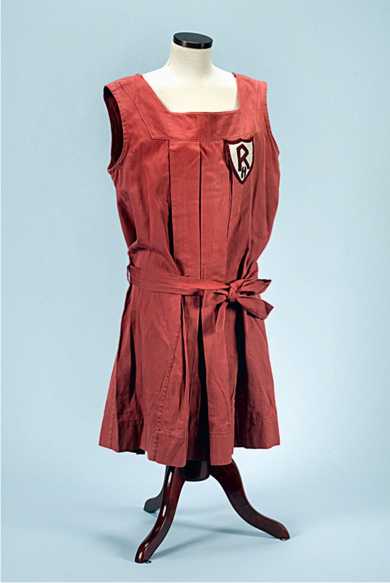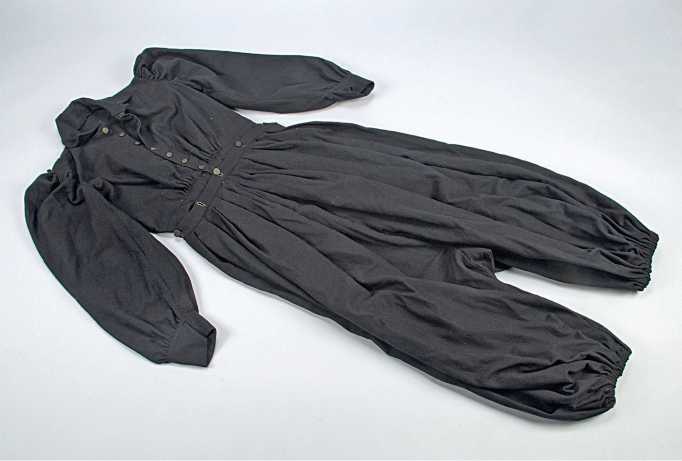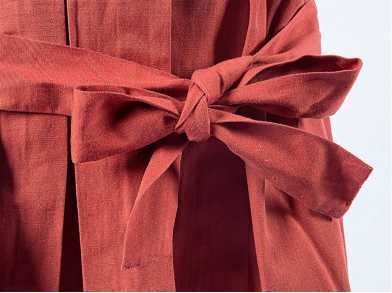A FIELD-HOCKEY DRESS: FIT FOR A KNOCKABOUT SPORT
Elizabeth Wright Plimpton wore this soft red dress when she played field hockey at Radcliffe in the 1920s.126 In 1987, she gave it to the Radcliffe Archives along with two bulging scrapbooks tied with black string. he dress is a more powerful record of her undergraduate days than the scrapbooks. he crumbling newspaper clippings stuffed into the scrapbooks contain little that is personal. Even her dance card from the “Radcliffe Promenade” is empty. In contrast, the hand-printed letters “PLIMPTON” on the inside of the back neck of the dress connect her
57. A lightweight cotton field-hockey dress worn by Elizabeth Wright Plimpton at Radcliffe College, around 1925, gave its owner freedom of motion. Arthur and Elizabeth Schlesinger Library on the History of Women in America.

To the college and the sport. he bright “R” with the little “H” beneath it affirms that she won her letter in hockey.
Plimpton’s red dress is not only a marker of her own lifelong commitment to sports; it is a document in the history of Radcliffe. Chartered by the commonwealth of Massachusetts in 1894, Radcliffe College was a hybrid institution, a compromise between decades-long efforts of women to secure admission to Harvard and the intransigence of Harvard overseers who believed that co-education was an untried and dangerous experiment. Its students secured access to Harvard faculty, who were paid extra for repeating their lectures at the college, but were segregated in all other ways from the parent university.127 Radcliffe secured its own identity as a college primarily through extracurricular activities. Initially the emphasis on physical activity at Radcliffe was a response to the arguments of Edward H. Clarke, a Harvard Medical School professor who warned that serious study might damage young women’s reproductive capacities. Advocates of female education retorted with campaigns for health and fitness. hey were determined to “hold students as strictly accountable for avoidable illness, faulty development, and crooked spines, as for failure in the academic branches.”128
By 1898, Radcliffe had its own gymnasium where students engaged in gymnastics, fencing, aesthetic dancing, and basketball.129 Basketball led to field hockey, then little known in the United States. As Elizabeth Wright, an early director of the gymnasium explained, “One day a graduate brought to me a young English woman who was anxious to learn the American game of basket ball. In talking over out-door sports with her,
I learned that she was an enthusiastic field hockey player____We agreed to
Teach her basket ball if she would teach us hockey.” he students cleared off an open space near one of the college buildings, laid out lines, and began to play. “his little field, too narrow, too short, and far too full of hummocks and hollows” served until 1913, when a better field was created.130 By then field hockey had become part of extracurricular life in other women’s colleges in the region. (he strong association of field hockey with women’s colleges may explain why a sport that is played competitively by men in other parts of the world is considered appropriate only for women and girls in the United States.)131
Here is no information on why Libby Plimpton’s parents named her Elizabeth Wright Plimpton. he surname “Wright” does not appear in any easily accessible family records. It is tempting to think that Plimpton’s full name reflects a friendship between her mother and Radcliffe’s early gym director, Elizabeth Wright. Wright arrived at Radcliffe while Libby’s mother was a student there. hat Edith Hall Plimpton was involved in sports is evident from the gymnasium suit that her daughter gave to Radcliffe along with her own field-hockey dress. he contrast between the two garments adds another layer to the history of Radcliffe and the history of women’s sports in general. Libby’s lightweight cotton uniform, meant to be worn with a short-sleeved white blouse and long stockings or knee socks was designed for maximum freedom. Her mother’s costume emphasized coverage. With a little help from stockings, the gymnasium dress completely encompassed the body. Small buttons reached from chin to waist. Full puffed sleeves ended in tight cuffs at the wrist. A voluminous “divided skirt,” what we today would call “bloomers,” disguised every possible contour of buttocks and thighs. Furthermore, the entire costume was made of wool. Waistbands on a separate bodice and skirt overlapped and were buttoned together, producing four layers of fabric around the waistline, perhaps compensation for the lack of a corset.

58. he heavy wool gym suit worn by Plimpton’s mother twenty years earlier had voluminous bloomers to conceal the wearer’s body during sports. Radcliffe College Archives, Arthur and Elizabeth Schlesinger Library on the History of Women in America.
He contrast between Edith Plimpton’s gymnasium suit and her daughter’s hockey dress exemplifies a crucial transition in women’s clothing and education in the early decades of the twentieth century. Contemporary instructions for cutting out a gymnasium suit make clear that the lower half of the garment was considered a “skirt.” Certainly it competed with many skirts in width, since the instructions called for joining two lengths of fabric—“more if you wish”—extending from waist to knees plus 9 inches. With fabric measuring from 36 to 42 inches in width, the circumference of the skirt would have ranged from 72 to 84 inches. In fact, the lower half of Edith Plimpton’s gym suit measures roughly 80 inches. Pleated to a waistband, it falls 18 inches, just as the instructions specified, and then divides into two legs. he transition between skirt and pants was marked by a gusset created by turning one point of a 9-inch square toward the front of the garment and the other toward the back. he “legs to the skirt” were then gathered at the bottom with an elastic casing.132
Despite its apparent modesty, this garment, when first introduced, was considered too risque for public view. Before dressing rooms were introduced into women’s gymnasiums, students at respectable colleges were warned to wear additional skirts over their gym costumes when walking to their rooms.133 Gymnasium bloomers exemplified Radcliffe’s ambivalence. hey supported female education, but wanted to maintain visible boundaries between the sexes. An outraged dean supposedly chastised the captain of the basketball team for allowing students to be photographed in their uniforms on the steps of the gymnasium. It was one thing to play in such garb, another to be seen wearing it outside.134
In the earliest photographs of field hockey at Radcliffe, taken around 1910, players wear full-length skirts and shirtwaists, sometimes with a long sweater or blazer. hey might as well have been playing croquet.135 Libby Plimpton’s field-hockey dress with its loose pleats and casual sash marked a new bravado and pride in being at Radcliffe. Women who participated in competitive sports helped to define the college as a school with spirit. A Radcliffe song, one of the few documents in Plimpton’s own handwriting in her college scrapbooks, makes that point:
Radcliffe girls they say are very busy People seem to think we all are grinds Folks believe that we have come to Radcliffe
Simply to cultivate our minds____
Now we’ll admit that we’re acquiring knowledge As everyone of us improves her mind
Altho we are at Radcliffe we have much besides our classes And we’ve much to do besides becoming grinds Yes, we’ve much to do besides becoming grinds.136
He song, filled with the spirit of the 1920s, asserted the importance of extracurricular activities in shaping college life.
But could girls engage in competitive sports and remain girls? Promoters of female education insisted that they could. As LeBaron Russell Briggs, president of Radcliffe College from 1903 to 1925, wrote, “he notion that a woman is at her best a sort of pretty fool with smelling salts is one of the first false notions that the girls’ college has dispelled.” He insisted that education actually made women better companions for their husbands and better guides and guardians for their children. Alluding to controversy over the place of athletics in the curriculum, he assured skeptics that “a slight athletic swagger in a young woman with a basketball halo does not mean that she will be mannish for life. It subsides, like the puffed cheeks of mumps—rather grotesque while it lasts, but not at all prophetic.”137 His defense of sports was earnest but condescending. He seemed to believe that participation in physically demanding activities was a temporary stage in a girl’s life, a “mannish” phase before she succumbed to romance and marriage.
Libby Plimpton’s life story challenges that assumption. After graduating from Radcliffe in 1929 with a degree in biology, she went to Wellesley College for a teaching credential in hygiene and physical education. hen, in the midst of the Depression, she took a teaching position at Alice Deal Junior High School in Washington, D. C., where she remained for thirty-six years, eventually becoming department head. She was not content simply to coach young girls. On her Radcliffe 25th-year reunion questionnaire, she proudly noted her own continuing involvement in competitive sports as a member of a number of women’s field-hockey teams in the southeast. She played in national tournaments in 1946, 1947, 1949, 1950, 1952, and 1953. “My position is goalie now,” she added.138
She remained physically active long after retirement. he March 1971 Radcliffe Quarterly noted that “Elizabeth Plimpton upheld our record on the ice with the Radcliffe Club of Boston at Watson Rink.” More intriguing was a full-page feature story in a local newspaper reporting on her roller skating activities, noting that her family had been “rolling along for more than 100 years” and that at the age of seventy-five, she had decided to take up the sport again. Her grandfather, James Leonard Plimpton, invented what is now considered to be the first modern roller skate, and her own father helped improve the design. She eventually donated some of their skates to the Smithsonian and others to the National Museum of Roller Skating in Lincoln, Nebraska. Long past the age of retirement, she

59. he sporty bow of the cloth belt of the knockabout field-hockey dress challenges the assertion made by contemporary male educators that female athletes were mannish and even grotesque. Arthur and Elizabeth Schlesinger Library on the History of Women in America.
Began skating every Tuesday at a rink in Waltham, Massachusetts. “I’m probably a little old for this,” she told the reporter, but, ever the teacher, added that it was certainly good exercise.139
Historians sometimes emphasize the importance of sports in developing self-confidence and a competitive spirit in women. Eleanor Roosevelt once claimed that the happiest day of her life was when she made the first team in field hockey at Allenswood School in England. Her biographer believes that reveals something essential about Roosevelt’s character. She “was a very competitive woman, a team player who delighted in the knockabout field of sport.” Eventually she carried those attributes into politics.140 Libby Plimpton did not share Roosevelt’s political views. She was proud of having attended a Girl Scout reception at the White House hosted by Mrs. Herbert Hoover, and in one of her reports to the Radcliffe Alumni, she admitted to being “impatient with young liberals.”141 But to the end of her life, she retained her passion for “knockabout” sports. Her college yearbook described her as “Erect, Practical, and Willing.”142 She was surely that. Like many women of her generation, she devoted herself to public education, community, and family. Although she did not marry, she cared for her eighty-five-year-old father after her mother died.143 She was a modest woman who never lost her athletic swagger.
L. T. U.




 World History
World History









